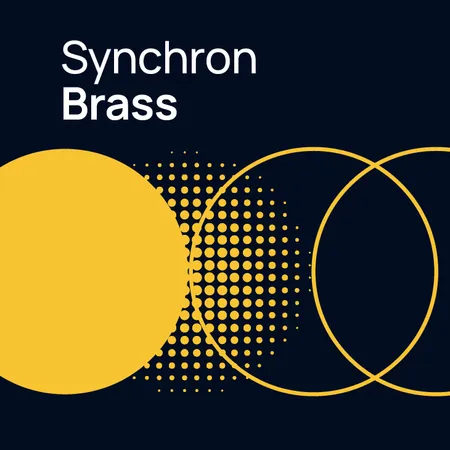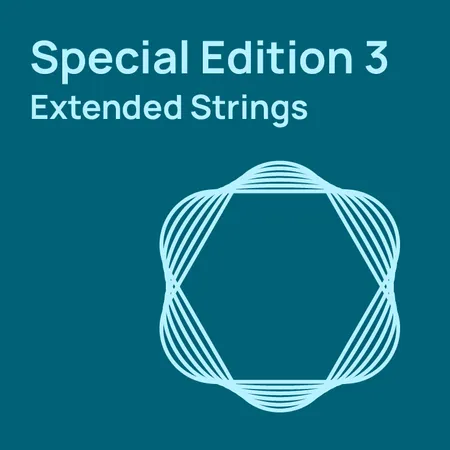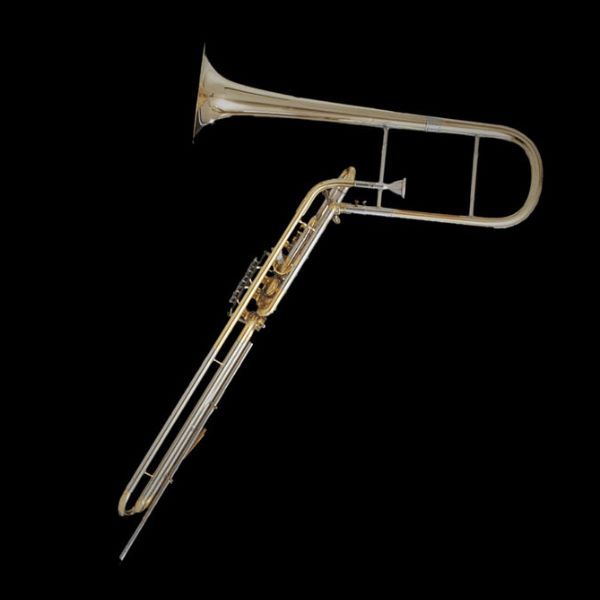
Classification: Aerophone, lip-vibrated instrument, brass wind instrument
Material: Brass, gold brass, nickel silver, gold lacquer
Mouthpiece: Deep cup mouthpiece (corresponds to the tuba's mouthpiece)
Tubing: Length 340 cm, cylindrical
Bore: Narrow, inner diameter 18.5 mm
Valves: Five valves (lowering pitch by 1, ½, 1½ steps, fourth-valve, 5th valve for the right thumb: wide whole step)
Bell: Rim diameter 27 cm
Adjustable tail-pin
The most striking feature of the cimbasso is the front-facing bell, which points slightly downward when the instrument is in the correct playing position. The cimbasso is about 120 cm high and is played in the sitting position, resting on the floor on a tail-pin or spike the length of which is adjustable. The five rotary valves are operated by the right hand, the 5th valve by the right thumb; the triggers of the first two valves are activated by the left hand.
The cimbasso is usually played by a tuba player because its mouthpiece is the same as the tuba's.
Today the instrument is made in two keys, F and Eb (four valves) and is of the valved contrabass trombone type.
Discover our Cimbassos
This valve was developed in Vienna by Joseph Riedl in 1835 and is now the most commonly used valve on brass instruments along with the Périnet or piston valve.
The term cimbasso emerged in Italy at the beginning of the 19th century and is probably an abbreviation of corno in basso (bass horn). Although the term was in everyday use among musicians, composers, conductors, publishers and instrument makers throughout the century, the meaning of cimbasso was clear only to the extent that it described nothing more or less than the voice below the trombones, the deepest brass voice in fact. This voice description was used consistently throughout the 19th century in Italy and is found in operatic scores from Bellini to Verdi and Puccini. However, the instruments that played this part differed over the course of time and from region to region.
At the beginning of the century the brass section's bass voice was the province of the serpentone, often also called the corno di basso (bass horn). A more advanced version of this instrument came from England and was a kind of serpentone in the form of a bassoon, made of brass and with nine finger-holes. It had the same range as the earlier serpentone. At this time the term cimbasso described both types of serpentone. The instrument from England presumably found its way into orchestral music by way of military bands and stage music. It is known to have been used at La Scala in Milan between 1815 and 1820. Later, similar instruments of the same type were called “Russian bassoon” or “Austrian contrabassoon” in Italy: their body was made of wood, the bell of brass and the mouthpiece of horn. The six finger-holes and two keys enabled a range from C2 to G4. The timbre of these instruments was said to be pure and powerful.
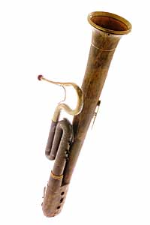
Serpent bassoon
From the 1830s onward the ophicleide, which had originated in France, gained popularity in Italy. The first models had keys, the later ones valves. The difference between the ophicleide and the bassoon-shaped bass horn - which remained in use as the cimbasso - was the fact that the former instrument was made of metal, only had keys and possessed a deeper range (to B1). Despite this the term cimbasso was also applied to the ophicleide. Verdi's early operas in the 1840s thus featured a valved ophicleide which was described as a cimbasso (Oberto, 1839, Nabucco, 1842, Ernani, 1844).
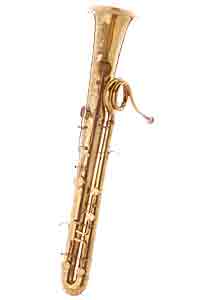
Ophicleide
In the years that followed, the bombardon became increasingly widespread in Italy. Over the years the bore of this bass instrument became wider and wider, while its construction and mechanism came to resemble the ophicleide so closely that the two instruments were barely distinguishable. The name cimbasso was therefore also used to describe the bombardon.
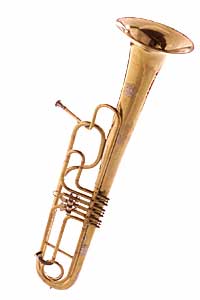
Bombardon (= Basshorn) in Eb, Vienna, Austria, August Heinr. Rott, between 1842 and 1846 (Museum of Musical Instruments, Schloss Kremsegg, Austria, Streitwieser collection)
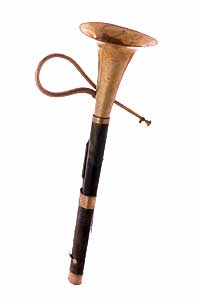
Wooden bombardon, anonymous, about 1850. Loan of the Heimatmuseum Bad Hall (Museum of Musical Instruments, Schloss Kremsegg, Austria, Streitwieser collection)
The trend toward imbuing bass instruments with an ever greater range and volume by means of increasingly wide bore profiles and a larger cone led in the mid-19th century to the construction of tuba-like instruments which had an entirely different timbre. Composers such as Verdi called for instruments with narrower bore profiles (e.g., in his opera Aida from 1871), because their timbre was better suited as the bass voice in a harmonic trombone section. This led to the birth in 1881 of the modern cimbasso. Giuseppe Verdi (1813-1901) inspired the Milanese instrument maker Pelitti to make a valved contrabass trombone with a bell facing forward. Although Verdi only ever wrote two scores specifically for this instrument after 1881 (Othello in 1887 and Falstaff in 1893) it nevertheless became traditional to perform the deepest brass part, including the 4th trombone in Verdi's earlier operas, on the “new cimbasso”. In fact, this tradition has now spread to encompass other Italian operas such as those by Gaetano Donizetti (1797-1848) and Vincenzo Bellini (1801-1835).
The cimbasso voice is written in bass clef and is non-transposing, analogous to the 4th trombone.
Range of the cimbasso: F1 - F4
As a rule notes from the 2nd natural are used, i.e. the pedal tones are not used - as is the case for the majority of cylindrical wind instruments.
On the cimbasso the playable natural harmonic series thus ranges from the 2nd to the 8th natural.
The five valves mean that the natural harmonic series of the fundamental F can be lowered by eleven steps, which means that the following natural harmonic series are available:
Natural harmonic series on F1: from 1st to 8th naturalNatural harmonic series from E1 down to Gb0: from 2nd to 8th natural
The chromatic scale is playable in its entirety over the whole range, with F1 as the only pedal tone; all the other notes in the instrument's compass can be played as natural 2 and above. Naturals 2 generally have greater substance than naturals 1.
The cimbasso is a very difficult instrument, the notes speak homogeneously and evenly.
Large leaps can be performed very well in legato. But the bigger the instrument the harder it becomes to perform large leaps. The playing of melodic and agitated bass lines is one of the cimbasso's specialties.
Easily playable at all pitch levels. Possible up to approx. MM 130. In the bass the notes speak a little more slowly.
Possible to a limited extent due to the amount of air required.
Sforzando
Forced, short attack followed by a rapid reduction in tone intensity.
Sforzandissimo
Forced, short attack with continuance of tone intensity.
Fortepiano
Rapid dynamic reduction from forte to piano.
Double tonguing
Not usual, difficult to perform.
Triple tonguing
Extremely difficult to perform.
Easy to perform.
A genuine glissando is not possible, but something approaching a glissando effect can be produced by half closing the valves.
Mutes are used to reduce the volume. They also brighten the sound.
Mellow, warm, soft, powerful, compact, metallic, sustaining, resonant.
The cimbasso's timbre is highly homogeneous throughout its range. Dramatic changes of register are not apparent. The overall sound is surprisingly mellow and warm, rich and resonant.
Lower registerF1 - G2
In this register the instrument sounds round, powerful and clear. It is less metallic and much more mellow than the contrabass trombone in the same register, as well as being more concise and compact than the tuba in the same register.
Middle registerG#2 - G3
In this register the sound is very mellow, soft, round and bright in parts.
Upper registerG#3 - F4
A continuation of the mellowness and softness of the middle register.
The cimbasso is the ideal instrument for the bass voice (4th trombone). The result is a powerful, four-voice section with barely surpassable homogeneity and sonority.
Because of its sound characteristics the cimbasso blends very well with the trombones and with the tubas. Good sound combinations are also achieved with trumpets and horns.
The combination of the cimbasso + contrabassoon produces a very mellow, full-sounding landscape of sound.
Vincenzo Bellini
- Norma (1831)
Giuseppe Verdi
- Otello (1887)
- Falstaff (1893)
Gaetano Donizetti
- Operas
Giacomo Puccini
- Operas
On this page
- Rotary valve
- History
- 19th century - cimbasso describes the deepest brass voice
- 1881: the modern cimbasso appears
- Notation
- Range
- Sound production
- Playing Techniques
- General
- Single Tonguing
- Vibrato
- Sforzato
- Double/triple tonguing
- Flutter tonguing
- Glissando
- Mute
- Legato
- Sound characteristics
- Sound Combinations
- Cimbasso + brass instruments
- Cimbasso + woodwinds
- Repertoire
